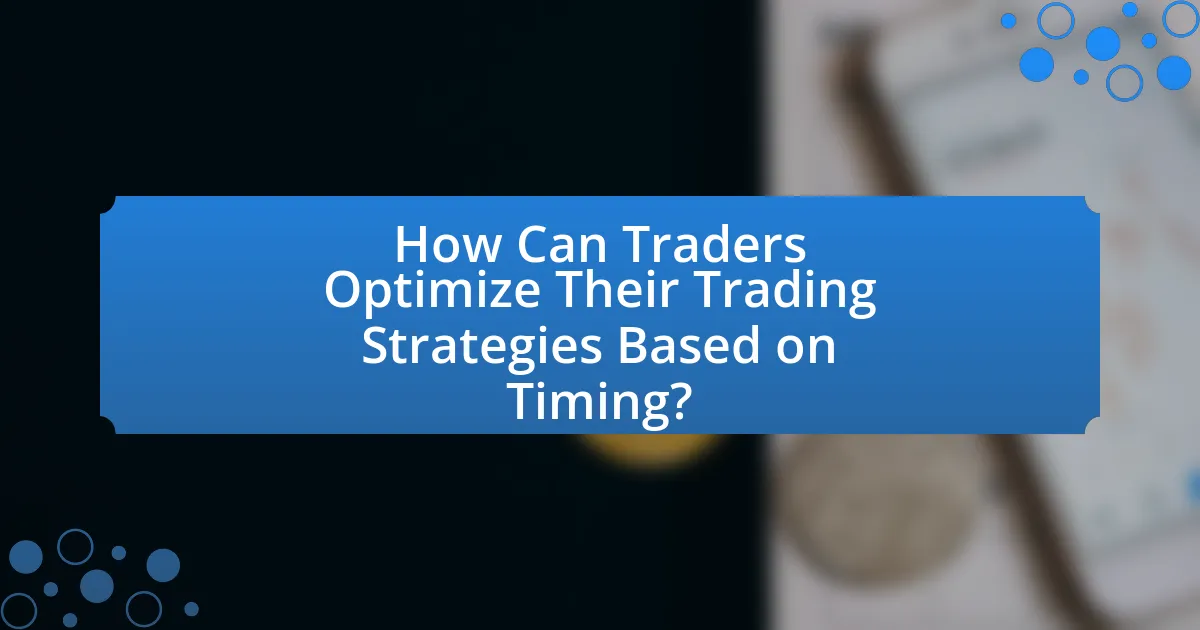The article focuses on identifying the best times to trade cryptocurrencies, emphasizing the influence of market volatility, trading volume, and global economic events on trading strategies. It outlines how market trends dictate optimal trading times, with key indicators such as price movements and market sentiment playing a crucial role. The article also discusses the significance of trading volume in timing trades, the impact of global events on market dynamics, and the best times of day for trading based on historical data. Additionally, it provides insights into analytical tools and best practices for traders to optimize their strategies based on timing, while highlighting common mistakes to avoid.

What Factors Influence the Best Times to Trade Cryptocurrencies?
The best times to trade cryptocurrencies are influenced by market volatility, trading volume, and global economic events. Market volatility indicates price fluctuations, which can create opportunities for profit; for instance, Bitcoin often experiences higher volatility during weekends. Trading volume reflects the number of transactions occurring, with higher volumes typically seen during weekdays, particularly when major markets like the U.S. and Europe are open. Additionally, global economic events, such as regulatory announcements or macroeconomic data releases, can significantly impact trading activity and price movements, making it essential for traders to stay informed about these factors.
How do market trends affect trading times?
Market trends significantly influence trading times by dictating the optimal moments for buying and selling assets. When a bullish trend is identified, traders often increase their activity during peak hours to capitalize on rising prices, typically observed during market openings or major news releases. Conversely, during bearish trends, trading volumes may decrease as traders become more cautious, often leading to reduced activity during off-peak hours. Historical data shows that cryptocurrency trading volumes tend to spike during weekends and major market events, indicating that traders adjust their strategies based on prevailing market conditions.
What are the key indicators of market trends?
Key indicators of market trends include price movements, trading volume, moving averages, and market sentiment. Price movements reflect the direction and strength of a trend, while trading volume indicates the level of interest and activity in a market. Moving averages, such as the 50-day and 200-day averages, help smooth out price data to identify trends over time. Market sentiment, often gauged through surveys or social media analysis, provides insight into investor attitudes and potential future movements. These indicators are essential for traders to make informed decisions about the best times to enter or exit cryptocurrency positions.
How can traders analyze market trends effectively?
Traders can analyze market trends effectively by utilizing technical analysis, which involves examining historical price data and chart patterns to forecast future price movements. This method allows traders to identify trends, support and resistance levels, and potential reversal points. For instance, the use of moving averages can help smooth out price data to identify the direction of the trend, while indicators like the Relative Strength Index (RSI) can signal overbought or oversold conditions. Historical data shows that traders who apply these techniques can improve their decision-making, as evidenced by studies indicating that technical analysis can yield higher returns compared to random trading strategies.
What role does trading volume play in timing trades?
Trading volume significantly influences the timing of trades by indicating market activity and liquidity. High trading volume often correlates with increased price stability and tighter spreads, making it an optimal time for executing trades. Conversely, low trading volume can lead to higher volatility and slippage, which may adversely affect trade execution. For instance, according to a study by the CFA Institute, periods of high trading volume are associated with more accurate price discovery, allowing traders to make more informed decisions. Thus, monitoring trading volume is essential for identifying the best times to enter or exit positions in the cryptocurrency market.
How can traders measure trading volume?
Traders can measure trading volume by analyzing the total number of shares or contracts traded within a specific time frame. This measurement is typically represented in charts and indicators, such as volume bars, which visually depict the amount of trading activity. For instance, a higher trading volume often indicates increased interest in a particular asset, which can signal potential price movements. According to data from CoinMarketCap, trading volume is a critical metric in cryptocurrency markets, as it helps traders assess liquidity and market sentiment, influencing their trading strategies.
What patterns in trading volume indicate optimal trading times?
In cryptocurrency trading, high trading volume patterns indicate optimal trading times. Specifically, periods of increased trading volume often correlate with significant price movements, making them ideal for executing trades. For instance, data from CoinMarketCap shows that trading volumes typically surge during major market events, such as regulatory announcements or technological upgrades, leading to heightened volatility and potential profit opportunities. Additionally, historical analysis reveals that trading volume peaks during specific times of the day, particularly during the overlap of major market sessions, such as when both the U.S. and European markets are active, further supporting the notion that these times are optimal for trading.
How do global events impact cryptocurrency trading times?
Global events significantly impact cryptocurrency trading times by influencing market volatility and trading volume. For instance, major geopolitical events, such as elections or international conflicts, can lead to increased uncertainty, prompting traders to react swiftly, which often results in heightened trading activity. Additionally, economic announcements, like interest rate changes or inflation reports, can cause rapid price fluctuations in cryptocurrencies, as traders adjust their strategies based on perceived risks and opportunities. Historical data shows that during events like the COVID-19 pandemic, trading volumes surged as investors sought to capitalize on market movements, demonstrating a clear correlation between global events and trading dynamics in the cryptocurrency market.
What types of global events should traders monitor?
Traders should monitor economic indicators, geopolitical events, regulatory changes, and market sentiment shifts. Economic indicators such as GDP reports, unemployment rates, and inflation data can significantly influence market trends and investor behavior. Geopolitical events, including conflicts, elections, and trade negotiations, can create volatility in financial markets. Regulatory changes, particularly those affecting cryptocurrencies, can lead to rapid price fluctuations, as seen with announcements from governments regarding cryptocurrency regulations. Lastly, shifts in market sentiment, often driven by news or social media trends, can impact trading decisions and market movements. For instance, the announcement of a major partnership or technological advancement in the cryptocurrency space can lead to increased investor interest and price surges.
How can traders prepare for the impact of global events?
Traders can prepare for the impact of global events by staying informed about geopolitical developments, economic indicators, and market sentiment. Monitoring news sources, economic calendars, and social media can provide insights into potential market movements. For instance, significant events like elections, trade agreements, or natural disasters often lead to volatility in financial markets, including cryptocurrencies. Historical data shows that during major global events, such as the COVID-19 pandemic, cryptocurrency prices experienced substantial fluctuations, highlighting the importance of being proactive. By utilizing tools like stop-loss orders and diversifying their portfolios, traders can mitigate risks associated with sudden market changes.

What Are the Best Times of Day to Trade Cryptocurrencies?
The best times of day to trade cryptocurrencies are typically during the overlap of major market sessions, specifically between 8 AM to 12 PM UTC and 8 PM to 12 AM UTC. These periods coincide with high trading volumes and increased volatility, driven by the activity of traders from different regions, including Asia, Europe, and North America. Historical data shows that trading volumes peak during these times, making it more likely for traders to find favorable price movements and opportunities.
How does the time of day affect cryptocurrency prices?
The time of day significantly affects cryptocurrency prices due to variations in trading volume and market activity. During peak trading hours, typically when major financial markets overlap, such as between 8 AM and 12 PM UTC, higher trading volumes can lead to increased price volatility and rapid price movements. Conversely, during off-peak hours, such as late night or early morning in major markets, trading volumes tend to decrease, resulting in less price movement and potential price stagnation. Historical data shows that Bitcoin, for example, often experiences higher price fluctuations during these peak hours, as evidenced by trading volume spikes reported by platforms like CoinMarketCap.
What are the peak trading hours for major cryptocurrencies?
The peak trading hours for major cryptocurrencies typically occur during the overlap of major financial markets, specifically between 8 AM to 12 PM UTC. This period aligns with the opening hours of both the European and North American markets, which significantly increases trading volume and volatility. Historical data shows that during these hours, trading activity spikes, as evidenced by higher transaction volumes and price movements, making it an optimal time for traders to engage in cryptocurrency trading.
How can traders identify off-peak trading opportunities?
Traders can identify off-peak trading opportunities by analyzing trading volume and market activity during specific times of the day or week. Off-peak periods typically exhibit lower trading volumes, which can lead to less price volatility and more favorable entry and exit points. For instance, data from cryptocurrency exchanges shows that trading volumes often decrease during weekends and late-night hours on weekdays, indicating potential off-peak times. By utilizing tools such as volume charts and historical trading data, traders can pinpoint these periods and adjust their strategies accordingly to capitalize on less competitive market conditions.
What time zones should traders consider when trading?
Traders should consider the UTC, EST, and GMT time zones when trading. These time zones are crucial because they align with major financial markets and trading sessions. For instance, UTC is the standard time reference for global trading, while EST corresponds to the New York Stock Exchange hours, which significantly influence cryptocurrency prices. GMT is relevant for European markets, particularly during the London trading session, which is one of the largest and most active in the world. Understanding these time zones helps traders identify peak trading hours and market volatility, enhancing their trading strategies.
How do different time zones affect market activity?
Different time zones significantly affect market activity by influencing trading volumes and volatility in financial markets. For instance, when major markets like New York and London are open simultaneously, trading activity typically increases, leading to higher liquidity and more price movements. According to data from the Bank for International Settlements, the foreign exchange market experiences peak trading volumes during the overlap of these time zones, which can also apply to cryptocurrency markets as they often follow similar patterns. Additionally, specific time zones may align with key economic announcements or events, further impacting market behavior.
What strategies can traders use to align with global trading hours?
Traders can align with global trading hours by utilizing a round-the-clock trading approach, which involves monitoring and participating in multiple cryptocurrency exchanges that operate in different time zones. This strategy allows traders to capitalize on market movements and liquidity across various regions, ensuring they are active during peak trading hours in major markets such as the United States, Europe, and Asia.
For instance, the overlap between the U.S. and European trading sessions typically sees increased volatility and trading volume, making it an optimal time for traders to execute their strategies. Additionally, employing automated trading systems or bots can help traders manage their positions and execute trades even when they are not actively monitoring the markets, thus maximizing opportunities across global trading hours.

How Can Traders Optimize Their Trading Strategies Based on Timing?
Traders can optimize their trading strategies based on timing by analyzing market trends, historical price movements, and trading volume patterns. By utilizing tools such as technical analysis, traders can identify key support and resistance levels that indicate optimal entry and exit points. For instance, studies show that cryptocurrency markets often exhibit increased volatility during specific hours, particularly when major exchanges in different time zones overlap, leading to higher trading volumes and potential profit opportunities. Additionally, traders can leverage algorithms and automated trading systems to execute trades at precise moments, capitalizing on short-term price fluctuations. This data-driven approach enhances decision-making and aligns trading activities with market dynamics, ultimately improving overall trading performance.
What tools can help traders identify the best trading times?
Traders can utilize technical analysis tools, trading platforms with built-in analytics, and market sentiment indicators to identify the best trading times. Technical analysis tools, such as moving averages and Bollinger Bands, help traders analyze price trends and volatility, allowing them to pinpoint optimal entry and exit points. Trading platforms like MetaTrader and TradingView offer real-time data and customizable indicators that assist in timing trades effectively. Additionally, market sentiment indicators, such as the Fear and Greed Index, provide insights into market psychology, helping traders gauge when to enter or exit positions based on prevailing market emotions.
How do trading bots assist in timing trades?
Trading bots assist in timing trades by utilizing algorithms that analyze market data and execute trades based on predefined criteria. These bots can process vast amounts of information, including price movements, trading volume, and market trends, much faster than a human trader. For instance, a trading bot can identify patterns such as support and resistance levels, enabling it to make informed decisions about when to enter or exit a trade. Additionally, trading bots can operate continuously, allowing them to capitalize on market opportunities that may arise at any time, including during off-hours when human traders are unavailable. This capability enhances the precision of trade timing, as bots can react instantly to market changes, thereby increasing the likelihood of profitable trades.
What analytical tools are available for timing analysis?
Analytical tools available for timing analysis in cryptocurrency trading include technical indicators, charting software, and algorithmic trading platforms. Technical indicators such as Moving Averages, Relative Strength Index (RSI), and Bollinger Bands help traders identify trends and potential entry or exit points. Charting software like TradingView and MetaTrader provides visual representations of price movements, allowing for detailed analysis of historical data. Algorithmic trading platforms utilize predefined strategies and automated execution to optimize trading times based on market conditions. These tools are widely used in the industry, as they enhance decision-making and improve the timing of trades.
What best practices should traders follow for timing their trades?
Traders should follow several best practices for timing their trades, including analyzing market trends, utilizing technical indicators, and being aware of market news. Analyzing market trends helps traders identify patterns and potential entry or exit points, while technical indicators, such as moving averages and Relative Strength Index (RSI), provide quantifiable data to inform decisions. Additionally, being aware of market news, such as regulatory changes or major announcements, can significantly impact price movements, allowing traders to time their trades more effectively. For instance, a study by the Journal of Finance found that traders who reacted to earnings announcements saw a 5% increase in returns compared to those who did not.
How can traders develop a personalized trading schedule?
Traders can develop a personalized trading schedule by analyzing their own availability, market trends, and trading strategies. First, they should assess their daily routines to identify the times they can consistently dedicate to trading. Next, they must study market patterns, such as peak trading hours and volatility, to align their schedule with optimal trading conditions. For instance, cryptocurrency markets often experience higher activity during specific time zones, particularly when major exchanges are open. By combining personal availability with market analysis, traders can create a tailored schedule that maximizes their trading effectiveness and aligns with their individual goals.
What common mistakes should traders avoid regarding timing?
Traders should avoid the common mistake of entering or exiting trades based solely on emotions rather than market analysis. Emotional trading often leads to impulsive decisions, resulting in losses; for instance, a study by the CFA Institute found that emotional decision-making can lead to a 20% decrease in trading performance. Additionally, traders frequently misjudge market timing by ignoring key indicators such as volatility and liquidity, which can significantly impact trade outcomes. Research indicates that trading during high volatility periods can increase risk, while low liquidity can lead to slippage, further emphasizing the importance of timing based on market conditions rather than personal sentiment.
What are the key takeaways for identifying the best times to trade cryptocurrencies?
The key takeaways for identifying the best times to trade cryptocurrencies include analyzing market trends, understanding trading volume, and monitoring news events. Market trends can be assessed through technical analysis, which reveals patterns and potential price movements; for instance, historical data shows that Bitcoin often experiences price surges during specific times of the day or week. Trading volume is crucial, as higher volumes typically indicate stronger market activity and can lead to more favorable trading conditions; data from CoinMarketCap indicates that trading volumes peak during weekends. Additionally, significant news events, such as regulatory announcements or technological advancements, can greatly influence market sentiment and price volatility, making it essential to stay informed.


